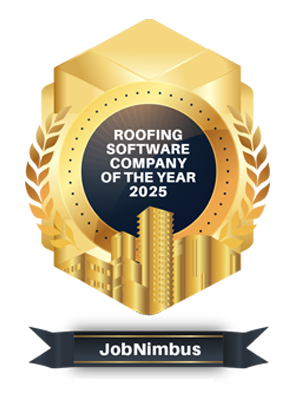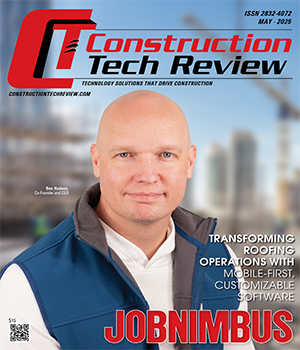THANK YOU FOR SUBSCRIBING
Running a roofing business is no easy task. One day, it’s about organizing incoming leads; the next, managing supply delays, tracking crew schedules, and keeping track of payments—all while ensuring customer satisfaction. Unfortunately, many contractors find themselves juggling sticky notes, spreadsheets, and disconnected systems that slow down operations and eat into profits. Relying on multiple tools for sales, scheduling, and billing might seem like a quick fix. But over time, it often leads to bottlenecks, missed deadlines, and lost revenue. Even more challenging, this disjointed approach can make scaling the business feel nearly impossible. Contractors are left with inefficiencies and administrative burdens that pull them away from what they do best—getting the job done. JobNimbus was created to break this cycle and transform how contractors run their businesses. Its flexible, customizable platform eliminates the frustration of manual processes and disconnected systems by providing a streamlined solution to manage everything in one place. By simplifying operations and enhancing efficiency, it empowers contractors to stay organized, boost profitability, and build a foundation for sustainable growth. Unlike rigid, one-size-fits-all platforms, the company is the only roofing software offering full customization to match how contractors work. Whether it is finetuning lead management, automating repetitive tasks, or creating custom templates for contracts and estimates, JobNimbus enables contractors to build optimized workflows that drive the best results. “We eliminate the need for multiple disconnected systems, saving time and reducing administrative burdens,” says Ben Hodson, co-founder and CEO of JobNimbus.
Top Project Management Solutions Provider 2025
The railroad and transportation industry continues to evolve, leaving no room for stagnation. For AJL Project Services, a notable player in project management, profession industry says recent years have been eventful, to say the least. Already into the eighth year of its venture in the RAIL SECTOR, the company has played pivotal roles in multiple maintenance of way rail infrastructure fastener production projects aimed at enhancing multimodal public transportation. The company operates as a vendor/ contractor, supplying maintenance equipment and maintenance parts to government transit agencies as needed. AJL Project Services also deploys their engineering, technical and project management skills for expansion and new projects for the Government Transit Agencies. So, for this contribution, the company has been recognized as one of the 10 promising project management solution providers in the U.S. “With over eight years of experience, AJL Project Services brings both general business management and project management skills to the industry,” says John Laditan, CEO at AJL Project Services. “Through general management, we manage the core business operations to deliver maximum returns, and with project management, we ensure timely project completions without budget and time overruns.” AJL Project Services uses the PMI PMP approach to project management. It also provides construction services, helping transit agencies in this domain. The company does construction as a full-fledged arm of the business and as a business product. AJL Project Services deploys a projectized management structure and outsources key business organic functions like accounting, marketing, etc.
Top 3D Printed Concrete Technology 2025
The search for a better way to build homes became personal for Lance Thrailkill after he lost a house to mold. Frustrated by traditional homes and their construction limitations exposed during the housing crisis, an emerging technology — 3D home printing — caught his eye. Around the same time, real estate veteran Craig Pettit had recognized the potential of 3D home printing and invested in a printer to create rental properties. Their paths crossed, and Thrailkill—owner of All Metals Fabricating and passionate about automation—became captivated by the technology. Seeing a chance to change the industry, they decided to collaborate and pivoted their portfolios to create PRINT3D Technologies. “Combining my manufacturing and automation expertise with Craig’s real-estate market knowledge in this company, we set out to disrupt the 3D home printing industry,” says Thrailkill, CEO and co-founder. The company 3D prints homes and manufactures 3D home printers to enable faster, more efficient and more sustainable construction. It is all set to lead the 3D home construction industry with its patented machine design, engineered to enhance overall system quality. Anticipating the widespread adoption of 3D home printing technology, PRINT3D Technologies strategically positions itself as the go-to provider for innovative building solutions. As cities refine inspection processes and implement green-tagging standards, the company stands ready to scale its impact, ensuring the industry keeps pace with growing demand. Unlike many peers who buy their machines from exclusive sellers, PRINT3D Technologies offers 3D home printing and sells house printing machines—a unique combination in the industry. It also employs an in-house feedback loop, which further refines the offering. The company’s partnership with All Metals Fabricating enables it to respond better to the market with the facility’s multi-million-dollar fabrication infrastructure. The facility’s world-class automation and engineers allow PRINT3D Technologies to operate independently and debt-free.
CXO INSIGHTS

Port Construction: Using an Unmanned Boat for Uncharted Territory
Sarah Johnson, Field Engineer Manager, McCarthy Building Companies, Inc.

Promoting Tech Implementation for Seamless Construction Project Management
Adam Krob, Director of Information Technology, Field Audit, and Process Improvement, Boh Bros. Construction

Leading Construction Projects with a Distinct Vision
Michael Phifer, Manager of Regional Services, Carolinas - Facilities Engineering Services, Terracon.

Integrating Tech into the Construction Industry.
David Pratt serves, the director of corporate and operational technology, Robins & Morton, a leading construction and engineering company

Fostering a Deeper Appreciation for Concrete's Impact on the Overall Project
Ken (Kenneth W.) Ottinger, Director of Quality Assurance / Quality Control, Kitchell
IN FOCUS
EDITORIAL
Embracing The Latest Technologies In Construction
The construction market is witnessing explosive growth due to rapid technological advancements, changing global priorities and economic fluctuations. The integration of construction software and technology spans all stages, from project initiation to completion. Construction businesses are increasingly relying on digital tools for project management activities like scheduling, planning, estimating and design. Consistent innovations enhance collaboration, improve efficiency, and meet the demands of complex construction projects. For construction managers, modern project management software incorporated with AI-driven analytics has become essential for staying ahead in the industry. Fail-proof resource planning and access to real-time data have also reduced construction project delays. Another significant trend is the development of 3D printing technology, which helps control the structure and shape of concrete, leading to more durable and high-quality buildings. It helps optimize material use and reduce waste, contributing to sustainable construction processes. It also speeds up construction, reduces human error and allows building complex shapes that were once considered impossible. Roofing software is also gaining traction in the construction industry, simplifying and organizing the workforce. It helps keep the projects on track and avoid costly mishaps by offering a centralized database of information and improving communication. Contractors can now create accurate estimates, track project progress and streamline communication with clients and team members. Realtime data and improved decision-making are helping reduce errors and enhance customer satisfaction, ultimately driving growth and success in the market. With these technologies, businesses can minimize confusion and manage work more effectively. In this edition of Construction Tech Review, we explore the recent developments and leading trends in project management software, 3D printed technology platforms and roofing solutions and how companies leverage cutting-edge solutions to stay abreast of challenges and potential potholes for establishing a strong presence among the public. We hope this edition of Construction Tech Review helps you find the right partner for your business requirements. Let us know your thoughts!

 Copyright © 2025 All Rights Reserved | by:
Copyright © 2025 All Rights Reserved | by: Construction Tech Review
| Subscribe | About us | Sitemap| Editorial Policy| Feedback Policy










